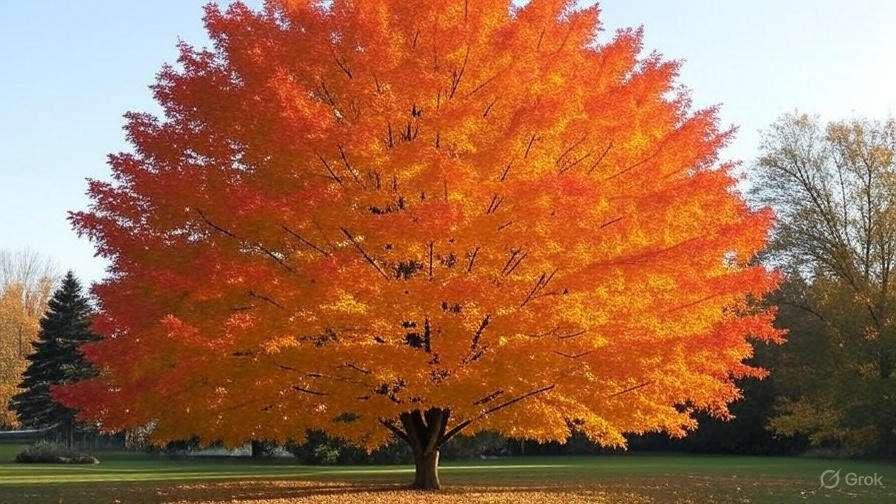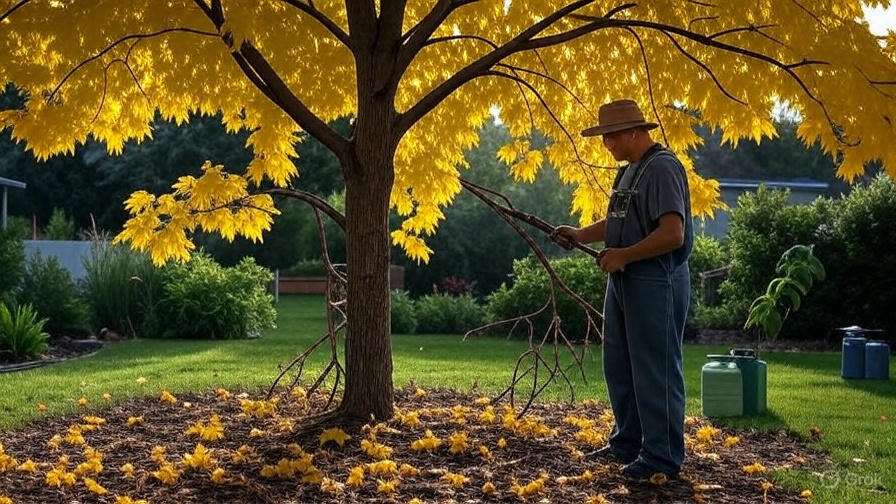
How to Care for Your Redpointe Maple Tree: Tips for Healthy Growth and Vibrant Fall Colors
The Redpointe Maple Tree is a showstopper in any landscape, with its stunning red foliage in the fall and vibrant green leaves during the spring and summer. 
In this guide, we’ll cover everything you need to know about caring for your Redpointe Maple Tree—from planting and watering to pruning and protecting it through seasonal changes. With the right knowledge and simple, actionable tips, you’ll be able to enjoy vibrant fall colors and healthy growth throughout the year. Keep reading to learn how to nurture your Redpointe Maple into a beautiful, thriving tree!
Table of Contents
ToggleWhy Choose a Redpointe Maple Tree for Your Landscape?
If you’re looking to add vibrant color, year-round interest, and a touch of elegance to your landscape, the Redpointe Maple is an excellent choice. Here’s why this beautiful tree stands out and why it’s perfect for your yard.
1. Stunning Fall Colors 
One of the biggest draws of the Redpointe Maple is its spectacular fall color. As the weather cools, the tree transforms into a fiery display of red, orange, and gold. This striking color change not only brightens your yard but also adds seasonal beauty that lasts for weeks. It’s the ideal tree to enhance the autumn atmosphere and create a stunning focal point in your landscape.
2. Low Maintenance 
Redpointe Maples are low-maintenance trees, making them a great option for homeowners of all experience levels. Once established, they are relatively pest-resistant and drought-tolerant, saving you time and effort on upkeep. Regular watering, occasional pruning, and a well-drained spot are all they need to thrive. No need for constant attention, just plant and enjoy!
3. Fast-Growing and Strong 
This tree grows quickly, reaching full size in just a few years. That means you get rapid results and a mature look in no time! Redpointe Maples also have a strong structure and sturdy branches, making them resilient to storms and harsh weather. If you want to enjoy the benefits of a large, mature tree quickly, this is your go-to option.
4. Versatile and Attractive Shape 
The Redpointe Maple boasts a beautiful, symmetrical shape with an upright form. It fits perfectly into a variety of landscapes, from suburban gardens to larger properties. Whether you’re planting it as a standalone feature, lining a driveway, or creating a shade canopy, this tree adapts well to different designs and spaces.
5. Ideal for Various Soil Types 
Redpointe Maples are tolerant of different soil conditions, including slightly acidic or alkaline soils. This makes them a versatile choice for a wide range of landscapes. As long as the soil is well-drained, the tree will flourish, making it an easy fit for almost any yard.
6. Eco-Friendly Benefits 

Planting a Redpointe Maple not only enhances the beauty of your landscape but also contributes to the environment. Trees are excellent at absorbing carbon dioxide, improving air quality, and providing habitats for wildlife. By choosing a Redpointe Maple, you’re also helping the planet.
7. Excellent Shade and Privacy 
The dense canopy of the Redpointe Maple provides excellent shade during the hotter months, keeping your yard cool and comfortable. This is perfect for creating a cozy outdoor space or reducing energy costs in your home. It can also provide some privacy from neighbors when planted strategically.
Final Thoughts
Choosing a Redpointe Maple for your landscape is a decision you won’t regret. With its stunning fall color, low maintenance, and fast growth, this tree adds both beauty and function to your yard. Whether you’re looking for shade, aesthetic appeal, or a tree that thrives in various conditions, the Redpointe Maple has it all.
So, if you’re ready to transform your landscape with a tree that delivers year-round charm and effortless care, consider adding a Redpointe Maple to your garden today!
Understanding the Growing Needs of a Redpointe Maple Tree
When you plant a Redpointe Maple, you’re investing in a stunning tree that will bring vibrant fall colors and years of beauty to your yard. But like any tree, it has specific needs to grow healthy and strong. Let’s break down what your Redpointe Maple needs and how to meet these needs effectively.

1. Sunlight: The Key to Strong Growth 
Redpointe Maples thrive in full sun. Ideally, they should get at least 6 hours of direct sunlight each day. More sun means more energy for the tree, which leads to healthier leaves and brighter fall color. If you plant your tree in a shady area, it may grow slower and have less vivid foliage in autumn. So, choose a sunny spot to plant your Redpointe Maple for the best results!
2. Watering: Consistency Is Crucial 
This tree loves consistent moisture, especially during its first few years of growth. Water your Redpointe Maple deeply but infrequently, ensuring the soil is moist but not waterlogged. A deep watering once a week should be enough, but during hot, dry spells, you may need to water more often. The key is to avoid letting the soil dry out completely, which could stress the tree.
3. Soil: Well-Drained and Fertile 
Redpointe Maples prefer slightly acidic to neutral soil that drains well. If the soil in your yard is heavy or clay-like, consider improving drainage by mixing in compost or other organic matter. A well-draining soil allows the tree’s roots to breathe, preventing water from pooling around them. Rich, fertile soil will also provide essential nutrients for optimal growth. If you’re unsure of your soil’s pH, a simple soil test can help you determine if any adjustments are needed.
4. Mulching: Protect and Nourish Your Tree 
Mulch is your best friend when it comes to keeping your Redpointe Maple healthy. Apply a 2- to 4-inch layer of mulch around the base of the tree, but make sure to leave some space between the mulch and the tree trunk. This helps retain moisture, regulate soil temperature, and prevent weed competition. Mulch will also break down over time, adding nutrients back into the soil. Keep an eye out for mulching that’s too thick, as it could suffocate the roots.
5. Pruning: Keep It Tidy 
While Redpointe Maples are generally low-maintenance, they do benefit from occasional pruning. Prune dead or damaged branches in early spring before new growth begins. This ensures a healthy structure and encourages better airflow, reducing the risk of disease. However, avoid heavy pruning, as it can stress the tree and reduce its vigor. A light trim to shape the canopy is all that’s needed!
6. Fertilizing: Keep It Balanced 
Redpointe Maples don’t require heavy fertilizing. In fact, over-fertilizing can harm the tree. However, applying a balanced, slow-release fertilizer in early spring can give your tree a gentle boost. Make sure the fertilizer is rich in essential nutrients like nitrogen, phosphorus, and potassium. If you notice yellowing leaves or slow growth, it may be a sign that your tree needs a bit more nutrition.
7. Protecting from Pests and Diseases 
While Redpointe Maples are generally resistant to many pests, it’s still a good idea to keep an eye out for common problems, such as aphids or fungal infections. If you notice sticky residue on the leaves or discolored spots, check for pests and treat accordingly. Regular inspections will help you catch issues early, before they become serious.
By paying attention to these essential care needs, your Redpointe Maple will thrive, growing tall and beautiful with brilliant fall colors for many years to come. 
How to Plant a Redpointe Maple Tree 
Planting a Redpointe Maple tree is a rewarding experience that can transform your yard with its vibrant fall colors and robust structure. Whether you’re a seasoned gardener or a beginner, the process is simple and straightforward. Here’s a step-by-step guide to help you plant your Redpointe Maple for long-term health and growth.
1. Choose the Right Location 
Start by selecting the perfect spot for your Redpointe Maple. These trees thrive in full sun, so pick a place where it will get at least 6 hours of direct sunlight each day. They prefer well-drained soil but can tolerate a range of soil types, including loam and clay. Avoid areas with standing water or heavy shade, as these can stunt growth.

2. Dig the Hole 
Dig a hole that’s about twice the width of the tree’s root ball but only as deep as the root ball itself. The goal is to give the roots plenty of room to spread out. Make sure the top of the root ball is level with or slightly above the ground surface to avoid water collecting around the trunk.
3. Prepare the Tree 
Carefully remove the Redpointe Maple from its container. Gently loosen the roots if they appear crowded or bound. If you’re planting a bare-root tree, soak the roots in water for a few hours before planting to ensure they’re hydrated.
4. Place the Tree in the Hole 
Position the tree in the center of the hole, making sure it’s straight. Hold the tree upright while you backfill the hole with soil. As you fill, gently tamp down the soil to remove air pockets, but avoid compacting it too much. The soil should remain loose enough for roots to grow easily.
5. Water the Tree 
After planting, water your Redpointe Maple generously to settle the soil around the roots. This helps prevent air pockets and encourages the roots to establish quickly. Continue to water deeply once a week for the first few months, especially during dry periods.
6. Mulch Around the Base 
Apply a 2-3 inch layer of mulch around the base of the tree, extending out a few feet. This helps retain moisture, suppresses weeds, and keeps the soil temperature stable. Avoid piling the mulch against the trunk, as this can cause rot.
7. Stake the Tree (If Necessary) 
If the tree is tall or the area is windy, you may want to stake it for extra support during its first year. Use soft ties and ensure the stakes are not too tight around the trunk. This will allow the tree to sway slightly and strengthen its trunk.
8. Monitor Growth and Care 
Over the following months, keep an eye on your Redpointe Maple. Water it regularly, especially during dry spells. Once established, the tree will be more drought-tolerant, but young trees need consistent moisture to grow strong. Watch for signs of pests or diseases and address them promptly.
Conclusion 
Planting a Redpointe Maple tree is easy with the right approach. By choosing a sunny location, preparing the soil, and caring for the tree properly, you’ll enjoy its stunning fall colors and lasting beauty for years to come. Happy planting!
Caring for Your Redpointe Maple Tree
Taking care of your Redpointe Maple Tree ensures it stays healthy and vibrant throughout the seasons. These trees are known for their striking fall color and strong structure, but they do require proper care to thrive. Here are practical and easy-to-follow tips for nurturing your Redpointe Maple:
1. Choosing the Right Location 
Redpointe Maples prefer full sun for at least six hours a day. Plant your tree in a spot with plenty of sunlight to encourage strong growth and vibrant color in the fall. Ensure the soil is well-draining—these trees don’t like wet feet!
2. Watering Your Redpointe Maple 
Watering is key, especially in the first few years. Ensure your tree gets a deep, consistent watering, especially during dry spells. A good rule of thumb is to water once a week, providing enough water to soak the roots without waterlogging the soil. Once established, Redpointe Maples are relatively drought-tolerant but still benefit from regular watering during dry periods.

3. Mulching 
A layer of mulch around the base of the tree helps retain moisture, regulate soil temperature, and prevent weeds from competing for nutrients. Spread 2–4 inches of organic mulch, like wood chips or shredded bark, but keep it away from the trunk to prevent rot.
4. Pruning 
Prune your Redpointe Maple tree during its dormant season (late winter or early spring) to remove any dead, damaged, or crossing branches. Regular pruning helps maintain the tree’s shape and ensures healthy airflow, preventing fungal diseases. Avoid heavy pruning in the fall to preserve the tree’s natural shape and encourage strong growth in the spring.
5. Fertilizing 
Fertilize your Redpointe Maple in early spring with a balanced, slow-release fertilizer. This will promote healthy growth, especially if the tree’s soil is lacking in nutrients. Avoid over-fertilizing, as this can lead to excessive growth at the expense of the tree’s root system. A soil test can help you determine if your tree needs additional nutrients.
6. Protecting from Pests and Diseases 
Redpointe Maples are generally hardy but can still be susceptible to pests like aphids or fungal diseases. Regularly inspect your tree for signs of trouble, such as discolored leaves or sticky residue. If you spot pests, treat them early with organic insecticides or remove them by hand. Fungal issues can often be managed by ensuring good air circulation and avoiding overwatering.
7. Winter Care 
In colder climates, protecting your Redpointe Maple from winter damage is important. Consider wrapping the trunk in tree wrap to prevent frost cracks. Also, avoid piling snow or salt around the base of the tree, as this can harm the roots. A thick layer of mulch will also help protect the root zone.
By following these simple care steps, you can help your Redpointe Maple thrive and enjoy its vibrant fall colors year after year. With the right attention and care, your tree will become a beautiful, long-lasting part of your landscape!
Seasonal Care for Redpointe Maple Trees 
Taking care of your Redpointe Maple tree throughout the year ensures it thrives, offering stunning fall colors and healthy growth. Here’s a simple seasonal guide to keep your tree vibrant and strong:

Spring: Time to Wake Up 
As the weather warms, your Redpointe Maple starts to wake up from dormancy. Here’s what you should do:
- Prune for Shape: Early spring is the best time to prune your tree before new growth begins. Remove dead or damaged branches to help the tree grow strong.
- Fertilize Lightly: Apply a balanced, slow-release fertilizer to give the tree a boost as it starts its growing season. Make sure the soil is moist before applying fertilizer.
- Water Regularly: Spring rains can be unpredictable, so keep the soil consistently moist (but not soggy). A deep watering once a week is usually enough.
Summer: Keep It Hydrated 
Hot summer months can stress your Redpointe Maple, especially if it’s newly planted. Here’s how to keep it healthy:
- Deep Watering: Water deeply to encourage deep root growth, especially during dry spells. A soaker hose or drip irrigation system can be very effective.
- Mulch: Apply a 2-3 inch layer of mulch around the base of the tree to retain moisture and keep the roots cool. Be sure to keep mulch away from the trunk.
- Monitor Pests: Check your tree regularly for pests like aphids or scale insects. Use an eco-friendly insecticidal soap if needed.
Fall: Prepare for Beautiful Colors 
Fall is when your Redpointe Maple shows off its vibrant reds and oranges. To ensure your tree is in top shape for this season:
- Water Less: Reduce watering as the tree prepares for dormancy, but don’t let the soil completely dry out.
- Fertilize: Apply a fall fertilizer with more potassium and phosphorus to encourage strong roots for the winter months.
- Prune After Leaf Drop: Once the leaves have fallen, prune to remove any dead or crossing branches, making it easier for the tree to focus on next year’s growth.
Winter: Protect and Rest 
Winter is a time for your Redpointe Maple to rest, but it still needs some care to get through the cold months.
- Watering: During mild winters, water occasionally if the soil is dry. Avoid overwatering, as frozen roots can lead to rot.
- Mulch for Insulation: Add an extra layer of mulch to insulate the roots against freezing temperatures, especially if you live in a region with harsh winters.
- Protect the Trunk: If you live in an area with heavy snow or ice, wrap the trunk with tree wrap to protect it from damage.
By following this seasonal care guide, your Redpointe Maple will remain healthy, beautiful, and vibrant year after year.
Common Problems and Solutions for Redpointe Maple Trees 
While Redpointe Maples are generally low-maintenance and resilient, they can experience a few common problems. Here’s how to tackle them effectively:
1. Yellowing Leaves 
Yellowing leaves, especially in late summer, can be a sign of stress or nutrient deficiencies.
Solution:
- Nutrient Deficiency: If your tree’s leaves are turning yellow, it might need a boost in nitrogen. Apply a balanced, slow-release fertilizer in spring to encourage healthy growth.
- Water Stress: Too much or too little water can also cause yellowing. Ensure the soil is well-drained but kept moist. Redpointe Maples prefer deep watering rather than frequent shallow watering.

2. Leaf Spot Diseases 
Leaf spot diseases like tar spot or anthracnose can cause black or brown spots on the leaves.
Solution:
- Prune Infected Leaves: Remove and discard any infected leaves to prevent the spread of disease.
- Good Air Circulation: Make sure your tree has enough space to breathe. Prune around the tree to improve airflow and reduce humidity around the foliage.
- Fungicide: In severe cases, use a fungicide labeled for maple trees to help control the spread.
3. Wilting or Drooping Leaves 
If your Redpointe Maple’s leaves are wilting, it could be a sign of insufficient water, especially during hot weather.
Solution:
- Deep Watering: Redpointe Maples have deep roots, so they prefer deep watering. Water thoroughly but infrequently to encourage root growth.
- Mulch: Adding a layer of mulch around the base helps retain soil moisture, keeping the roots cool during summer heat.
4. Poor Fall Color 
A Redpointe Maple’s stunning fall color is one of its main attractions, but sometimes the leaves don’t turn as vibrant as expected.
Solution:
- Sunlight: Ensure your tree is getting at least 4–6 hours of direct sunlight a day. Redpointe Maples need plenty of sun for their colors to really pop in the fall.
- Watering and Soil: Sometimes poor fall color is linked to water stress. Make sure your tree is not waterlogged or too dry. Healthy soil with good drainage is key for vibrant foliage.
5. Branch Dieback 
If you notice that branches are not leafing out in spring or that they appear to be dead, it could be caused by winter injury or poor pruning.
Solution:
- Prune Dead Branches: Trim away any dead or damaged branches in early spring to promote healthy growth.
- Winter Protection: Wrap young trees in burlap during the winter months to protect them from freezing winds and temperature fluctuations.
6. Pests 
Redpointe Maples can be susceptible to pests like aphids, scale, or spider mites. These insects can cause damage to leaves, leading to a weakened tree.
Solution:
- Regular Inspection: Check your tree regularly for signs of pests. If you spot insects, spray the affected areas with a gentle insecticidal soap or use a horticultural oil to smother the pests.
- Beneficial Insects: Encourage beneficial insects like ladybugs, which naturally control aphid populations.
7. Root Rot 
Root rot can occur if the tree is planted in poorly-drained soil or if overwatering is a regular issue.
Solution:
- Well-Draining Soil: Ensure that your tree is planted in soil with good drainage. If you suspect root rot, gently remove the tree from the soil to inspect the roots. Trim away any brown or mushy roots and replant the tree in well-draining soil.
- Proper Watering: Avoid overwatering your Redpointe Maple. Water only when the top few inches of soil feel dry to the touch.
By understanding these common issues and how to address them, you’ll help your Redpointe Maple thrive, ensuring it stays healthy and vibrant for years to come!
Conclusion
Caring for your Redpointe Maple Tree is an investment in both beauty and long-term health. With the right attention to watering, pruning, and seasonal care, you can ensure that your tree thrives and continues to dazzle with vibrant fall colors year after year. Whether you’re planting a new Redpointe Maple or nurturing an established tree, the tips shared in this guide will help you create the ideal environment for growth and success.
Remember, the key to a flourishing Redpointe Maple lies in consistent care, from choosing the right planting spot to maintaining healthy soil and ensuring protection from pests and diseases. By following these simple steps, your Redpointe Maple will be a standout feature in your landscape, offering beauty and shade for many seasons to come.
So, go ahead and give your Redpointe Maple the care it deserves—your tree will thank you with stunning colors and healthy growth!
Frequently Asked Questions(FAQ)
How fast does a Redpointe Maple tree grow?
Redpointe Maples are considered fast-growing trees, typically adding 1-2 feet of height per year. Under ideal conditions, they can reach up to 30-40 feet tall. Regular care, including proper watering and fertilizing, can support faster growth.
When is the best time to plant a Redpointe Maple tree?
The best time to plant a Redpointe Maple is during early spring or fall. These seasons provide mild temperatures, allowing the tree to establish its root system before the extremes of summer heat or winter cold.
How much sunlight does a Redpointe Maple tree need?
Redpointe Maples prefer full sun to partial shade. To achieve the best growth and vibrant fall colors, plant the tree in an area that receives at least 6 hours of direct sunlight each day.
Why are the leaves on my Redpointe Maple turning yellow?
Yellowing leaves on a Redpointe Maple can be caused by overwatering, poor drainage, or nutrient deficiencies. Check the soil for proper drainage, and consider applying a balanced fertilizer to correct any nutrient imbalances.
How do I prune a Redpointe Maple tree?
The best time to prune a Redpointe Maple is in late winter or early spring before new growth begins. Remove dead, damaged, or crossing branches to improve air circulation and maintain a healthy structure. Avoid heavy pruning during the growing season to prevent stress on the tree.
What should I do if my Redpointe Maple isn’t showing vibrant fall colors?
If your Redpointe Maple is not displaying vibrant fall colors, it may not be receiving enough sunlight. Ensure the tree is planted in a sunny location. Also, proper watering and avoiding over-fertilization can help enhance fall color intensity.
How often should I water my Redpointe Maple tree?
Water your Redpointe Maple deeply once a week during dry spells, especially during the first few years after planting. Make sure the soil is well-drained to prevent waterlogging, which can lead to root rot. Adjust watering frequency based on rainfall and temperature.
How can I protect my Redpointe Maple tree during the winter?
To protect your Redpointe Maple during winter, apply a layer of mulch around the base to insulate the roots. You can also wrap the trunk with burlap or use a windbreak to shield the tree from harsh winter winds, especially in colder climates.




